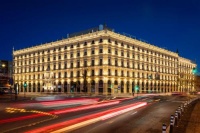Macarena district of Seville City
Next to the Alameda, this is an authentic Seville barrio; although many houses have been restored and smartened up in recent years to attract young professional types, thankfully it hasn't gone too chi-chi. You'll find trendy clothes shops, of the street-style skateboarder variety, as well as artists' communities. The food market on Calle Feria is one of the city's best and the "El Jueves" Thursday flea market is fun for bargain-hunting. The area is home to one of Seville's two favourite Virgins, the Virgen de Esperanza, a focus of intense adoration during Semana Santa.
La Macarena covers the northern-eastern area of the old city, up to Moorish city walls. Once the poorest slum in Spain, it's now a characterful area with many churches to visit, and interesting palaces and plazas; lots of crumbling old mansions have been restored, although some still remain in a sorry state. The area is home to a number of artists' corrales, where artisans and performers have small premises in shared courtyards, hosting workshops and performances, as well as communal workspaces for architects, translators and writers.
The oldest and busiest flea market in Seville, El Jueves, is held on Calle Feria every Thursday, while the Calle Feria food market has great fruit and vegetable stalls, as well as organic goods, and fresh artesan bread and cakes.
The Convento de Santa Paula has a small museum which is open to the public, as well as a shop selling its home-made jams and cakes, while next door the Mudéjar-Gothic Iglesia de San Marcos, built on the site of a mosque, has a Giralda-like tower and horseshoe-shaped arches.
At the top of Calle San Luis is the Basilica de la Macarena, where you can see one of Seville's best-loved virgins, La Macarena de la Esperanza (the hit song was about one of the many Sevillian women named after her). The much-venerated Virgin statue was made by Luisa Roldán in the late 17th century. Her departure from the church on Thursday night (La Madrugada) is Semana Santa´s high point: carried on a solid silver paso (float) and dressed in this year's new outfit, she is greeted by ecstatic weeping and wailing from her thousands of adoring followers. You'll see her golden-haloed image in hotels, bars, shops and taxis all over the city. The bullfighter Joselito adored her and bestowed upon her the five emeralds she wears. When he died, she was dressed in black for the following Semana Santa to mourn him.
This church is next to the Puerta de Córdoba, the old entrance to the barrio, which was one of the many gates in the Muralla, the old Arab city wall. This is a crumbling but still impressive reminder of the original fortified Seville.
Opposite the basilica is the large Renaissance Hospital de Cinco Llagas, these days home to the Andalucian parliament. At the end of this road you'll find the elegant Puente de la Barqueta (Boat Bridge), built for Expo 92 by Santiago Calatrava, which leads to Isla de la Cartuja.

